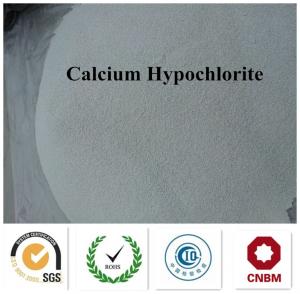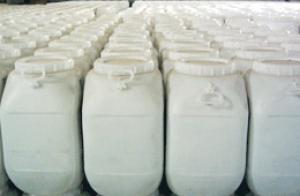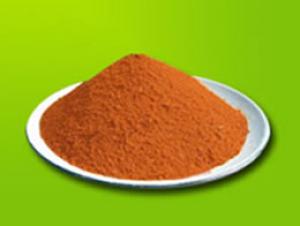PAFC Water Treatment Chemical
- Loading Port:
- Tianjin
- Payment Terms:
- TT OR LC
- Min Order Qty:
- -
- Supply Capability:
- 6000 m.t./month
OKorder Service Pledge
OKorder Financial Service
You Might Also Like
Water treatment material Polyaluminium ferric chloride(PAFC)
Brief introduction:
Polyaluminium ferric chloride (PAFC) is made up of aluminum salt and iron salt coagulation hydrolyzing and become
a kind of inorganic polymer coagulants, based on the principle of synergies, join the elemental iron ion or three iron
oxide and other compounds containing iron composite is a new type of high efficient coagulant.
It combines merits for aluminum salt and iron salts of aluminum ion and iron ion form has improved significantly,
polymerization degree is greatly improved. Aluminum, iron coagulant respectively of the advantages of air flotation
operation, improve the concrete performance of polyaluminium chloride; For high and low temperature and low
turbidity water water purification treatment effect is particularly evident, needn’t add alkaline additives and other
coagulant aid.
performance:
1, fast hydrolysis and weak hydration. Dense alumem ustoum, sedimentation speed.Affected by the temperature
change is small, can meet the requirements of shear force in the process of flow.
2, solid product is brown, reddish brown powder, easily soluble in water.
3, which can effectively remove the aluminum ion in the raw water and remaining free aluminum ion in water after
aluminum salts coagulation.
4, wide applicable scope, drinking water, industrial water, water, sewage and industrial wastewater treatment, etc.
5, Less dose, treatment effect is good, cut down the cost of 10-20% than other coagulants.
6, using method and packaging purposes matters is essentially same as polyaluminium chloride.
features:
1, the dosage is far lower than the traditional flocculant,the water quality is good after purification.
2, the flocculation body is formed fast, precipitation is rapid, is bigger than traditional products processing capacity.
3, the alkalinity of the water consumption, less water lower PH.
technology classification:
1, drum-type poly aluminum chloride, general aluminum content, high water insolubles, used for sewage treatment.
2, frame type poly aluminum chloride has high aluminum content, low water insolubles, used in sewage treatment
and drinking.
3, spray drying, poly aluminum chloride has high aluminum content, low water insolubles , faster dissolve. used
for potable water and higher standards water treatment.
name of index | index | |
PAFC | ||
liquid | solid | |
relative density(20°C) ≥ | 1.19 |
|
PH value(1%aqueous solution) | 3.5-4.5 | 3.5-4.5 |
(AL2O3i)content% | 10.0 | 29 |
(Fe2O3)content% | 1-2 | 2-3 |
basicity,% | 60-95 | 60-95 |
water insoluble,% < | 0.3 | 1.0 |
(As)content,% ≤ | 0.0003 | 0.0006 |
(Mn)content,% ≤ | 0.045 | 0.01 |
(SO2-)content % | 3.5-9.6 | 3.5-10 |
purposes:
Polyaluminium ferric chloride has widely scope of application: used in drinking water, industrial water, sewage
and industrial wastewater treatment, polyaluminium ferric chloride has obvious effect with all kinds of industrial
water and drinking water purification treatment.
- Q: Nutritional characteristics of carbohydrates and inorganic salts in vegetables
- Inorganic salts are absorbed and utilized by crops in the soil. Carbohydrates are composed of carbon (C) and water (H20). Each person's body contains carbohydrates.
- Q: What do we get from the milk?
- Milk is rich in minerals, calcium, phosphorus, iron, zinc, copper, manganese, molybdenum. The most rare is that milk is the best source of calcium in the human body, and the proportion of calcium and phosphorus is very appropriate, conducive to the absorption of calcium. Species is complex, at least 100 kinds, the main ingredients are water, fat, phospholipids, protein, lactose, inorganic salts
- Q: What foods contain zinc-containing inorganic salts
- No. 4: Chibi (11.58 / 34g / 100g)
- Q: What cells produce the collagen and inorganic salts of bone matrix?
- The collagen is produced by chondrocytes. The minerals that make up the bone are precipitated by osteoblasts.
- Q: Cells are composed of water and inorganic salts or by organic matter and none
- Cells are composed of water and inorganic salts or b
- Q: What is the disease of inorganic salt crystals?
- It is recommended to drink boiled water.No need to take medication.
- Q: Inorganic salts are not nutritious
- Nutritional substances are sugar protein fat three nutrients
- Q: People lack the inorganic salt will be what disease
- iodine deficiency can lead to illness, children and adult goiter, hyperthyroidism and so on.
- Q: therefore indigestible..that I should look for organic plant based trace mineral compounds..anyone care to comment?
- All trace minerals are "inorganic". That's what a mineral is. What the article means is that they are inorganic in the sense that the supplements just have mineral compouds, rather than being derived from a food source. That doesn't make them indigestible, but it can mean they aren't as readily absorbed. Vitamins and minerals are ALWAYS absorbed better when derived from food sources, such as eating a balanced diet, then they are by popping a supplement with a mineral compound in it. But if you need supplements, I don't know if there's such a striking difference between regular mineral supplements or "plant-based" whole food supplements. I don't doubt that whole food plant supplements are probably better, but I don't know that they're better to the degree that it makes the regular supplements "terrible". The best source is STILL diet.
- Q: Please tell in your own language how water and inorganic salts are transported from the soil to the leaves.
- The roots of plants are usually divided into roots, lateral, small roots, small roots (roots, roots and roots) for the absorption of roots, the absorption of roots from the soil to absorb water and inorganic salts, through the transport organization to reach the xylem of the catheter, through The ducts are delivered to the various organs of the plant (including the leaves).
Send your message to us
PAFC Water Treatment Chemical
- Loading Port:
- Tianjin
- Payment Terms:
- TT OR LC
- Min Order Qty:
- -
- Supply Capability:
- 6000 m.t./month
OKorder Service Pledge
OKorder Financial Service
Similar products
Hot products
Hot Searches
Related keywords























